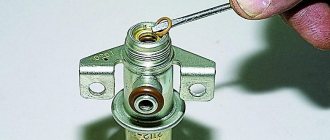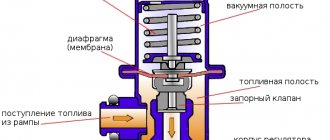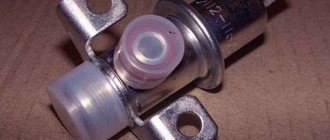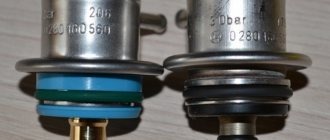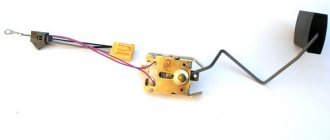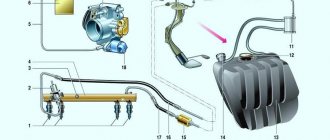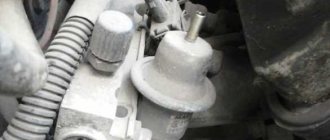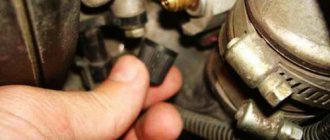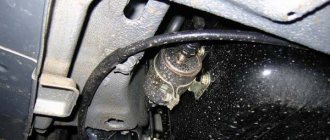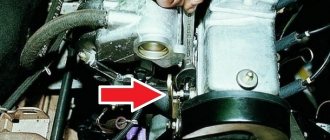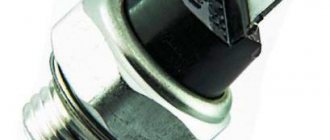It is most difficult for novice motorists to monitor the condition of their car. They do not yet know the main signs of failure of its parts and often miss the first manifestations of malfunctions. The manufacturer installed a weak fuel pressure regulator on the VAZ-2115. Therefore, it is important to learn how to check it and replace it.
Regulator location
It is located in the side and at the top of the ramp; you can see its location in more detail in the photo below. The regulator is indicated by two arrows: the red arrow shows its approximate location, and the blue arrow shows the regulator itself. It is easy to find and quite simple and quick to change.
Where is the fuel pressure regulator on the VAZ 2115
When is it necessary to change the regulator?
The main signs of malfunction of this part are described in the preface to the article, but I would like to add a little. The regulator is similar to a valve and has two positions: open (bleeds off excess pressure) and closed (pressure does not leave the system, remaining in it - typical when the engine is turned off, when the pressure should not leave the system so that after some time you can get into the car and start it without any problems). Over time, the regulator wears out and ceases to perform its functions.
Usually, it gets stuck in one position - it either becomes completely open or completely closed. Then the pressure in the system becomes constantly low (the freeze occurred in the “open” position), or it increases significantly (the regulator remains in the “closed” position). In both cases, the malfunction affects the ride quality and wear of parts, therefore, if a problem is detected, we recommend that you replace the failed part and continue to enjoy full driving of the car.
Important! If you are not sure that the problem lies in the regulator, then before replacing, we recommend checking the spare part for functionality. You will need a pressure gauge. The cost of this device in car dealerships ranges from 1000 rubles and more. We strongly do not recommend purchasing a device that is too expensive, since you probably do not intend to use it constantly for professional purposes. You can use a life hack: try driving to a service center and renting a pressure gauge, it will be much cheaper. We filmed the procedure for checking the regulator.
How to properly check RTD
In order to independently check the pressure in the system, and therefore the correct operation of the regulator, you need to take a pressure gauge, the maximum pressure in which is up to 10 atmospheres. You should not use a device with a larger scale, as its readings will have a serious error.
It connects between the fitting and the fuel pipe:
- first turn off and cool the engine;
- locate the fuel rail under the hood;
- remove the plug from the fuel pressure fitting;
- unscrew the fitting nipple using a spool valve;
- wipe the surfaces if fuel splashes appear under the influence of residual pressure;
- pull a hose with a diameter of up to 9 millimeters onto the fitting and secure it with a clamp;
- Connect the second hole of the hose to the pressure gauge.
Next, you will need an assistant, because the readings from the pressure gauge need to be read at one of four moments:
- when the ignition is turned on, the pressure should be 3 atmospheres;
- at idle speed - 2.5;
- when squeezing the fuel outflow hose - 7;
- with the hose removed on the RTD – 3.3.
If on your VAZ-2115 the measurements show different indicators, then you need to replace the regulator with a new one. To do this, it is enough to detect it in the system, dismantle it, and then return the fuel line to its original state. In the VAZ-2115, the engine of which has 8 valves or another system, the RTD is mounted at the very end of the fuel rail.
It is important to check the integrity of the fuel system. If leaks are detected in it, then the pressure gauge readings should not be trusted. After checking under different conditions, it is worth turning off the engine and looking at the pressure gauge again; the pressure should be within 0.7 atmospheres. If the pressure drops completely, then the problem is definitely in the regulator.
Remember that a regulator will cost you much less than a large-scale repair of the fuel system or engine. It is precisely such global breakdowns that a failed RTD can lead to. The cost of this spare part is from 500 rubles. The final price of the repair depends on which manufacturer’s spare part you purchase. The cheapest parts are stock parts produced in Togliatti, and the most expensive are BOSCH components.
Why is this device needed?
The regulator, responsible for maintaining normal fuel pressure in the system, is in direct interaction with the power unit. According to its location, it can be located in the fuel tank or in the rail (this is where you will be able to find the regulator if you have an injection VAZ-2115). The reason for the failure of this element is often the low quality of gasoline. If you fill up at gas stations with greatly reduced prices, then it is not surprising that very soon the regulator will fail.
The fuel flows through the injectors to the intake manifold, and it is important that its pressure does not change at this moment. The regulator measures the volume of fuel required for engine operation, and also monitors the pressure in the fuel rail and intake manifold.
The main task of the RTD is to maintain the pressure difference at the same level, as well as monitor the indicators.
How does the fuel pressure regulator work?
Structurally, the old-style valve (installed on gasoline cars) has its own body, inside which there is a valve, a membrane and a spring. The housing has three fuel outlets. Through two of them, gasoline passes through the pressure regulator, and the third outlet is directly connected to the intake manifold. At low (including idle) engine speeds, the fuel pressure in the system is low and it all goes into the engine. As the speed increases, the corresponding pressure increases in the manifold, that is, at the third terminal of the RTD, a vacuum (vacuum) is created, which, at a certain value, overcomes the resistance force of its spring. This creates the movement of the membrane and the opening of the valve. Accordingly, excess fuel gains access to the second outlet of the regulator and goes back into the fuel tank through the return hose. Due to the described algorithm, the fuel pressure regulator is often called a check valve.
As for the fuel pressure sensor, it is a little more complicated. So, it consists of two parts - mechanical and electrical. The first part is a metal membrane that bends under the influence of force caused by pressure in the fuel system. The thickness of the membrane depends on the pressure for which the fuel system is designed. The electrical part of the sensor consists of four strain gauges connected according to a “Winston bridge” circuit. Voltage is applied to them, and the more the membrane bends, the greater the output voltage from them will be. And this signal is sent to the ECU. As a result, the electronic control unit sends the appropriate command to the pump so that it supplies only the amount of fuel required at the moment.
Diesel engines have a slightly different fuel pressure regulator design. In particular, they consist of a solenoid (coil) and a rod, which rests against the ball to shut off the reverse flow. This was done for the reason that the diesel engine vibrates very strongly during its operation, which affects the wear of the classic (gasoline) fuel regulator, that is, partial and even complete compensation of hydraulic vibrations occurs. However, its installation location is similar - in the engine fuel rail. Another option is on the fuel pump housing.
Messages 12
1 Topic by Ser_vas_xxx 2014-03-13 18:28:45
- Ser_vas_xxx
- New member
- Inactive
- Registration: 2014-03-07
- Messages: 30 Thanks : 1
- Auto: 21124
Topic: Where is the check valve in the fuel pump
After diagnostics, the control valve in the fuel pump was said to be clogged
The pressure is already 4.5 they told me to clean it, where and how to clean it?! Machine 21124 1.6
2 Reply from chev-viktor 2014-03-13 20:04:39
- chev-victor
- New member
- Inactive
- From: Rostov-on-Don
- Registration: 2014-02-17
- Messages: 96 Thanks : 7
- Car: VAZ2112
Re: Where is the check valve in the fuel pump
The check valve is not cleaned in the fuel pump but in the fuel system
3 Reply from kapelkaK 2014-03-13 21:09:12 (2014-03-13 21:10:03 edited by kapelkaK)
- kapelkaK
- Experienced
- Inactive
- From: Ramenskoye, Moscow.
- Registration: 2013-12-16
- Messages: 313 Thanks : 94
- Car: VAZ 2111, 2001, 1.5; 8V; January 5.1; BK ShtatKh4m.
Re: Where is the check valve in the fuel pump
In what place exactly?
4 Reply from sergo9531 2014-03-13 21:15:38
- sergo9531
- Local
- Inactive
- From: Domodedovo
- Registration: 2014-01-12
- Messages: 578 Thanks : 208
- Auto: 21114
Re: Where is the check valve in the fuel pump
5 Reply from kapelkaK 2014-03-13 21:34:23
- kapelkaK
- Experienced
- Inactive
- From: Ramenskoye, Moscow.
- Registration: 2013-12-16
- Messages: 313 Thanks : 94
- Car: VAZ 2111, 2001, 1.5; 8V; January 5.1; BK ShtatKh4m.
Re: Where is the check valve in the fuel pump
Added: 2014-03-13 22:34:23
6 Reply from sergo9531 2014-03-13 21:36:14
- sergo9531
- Local
- Inactive
- From: Domodedovo
- Registration: 2014-01-12
- Messages: 578 Thanks : 208
- Auto: 21114
Re: Where is the check valve in the fuel pump
kapelkaK , it is the opposite. through it, excess fuel is drained into the tank. This way the pressure is regulated))
7 Reply from kapelkaK 2014-03-13 21:39:10 (2014-03-13 21:39:45 edited by kapelkaK)
- kapelkaK
- Experienced
- Inactive
- From: Ramenskoye, Moscow.
- Registration: 2013-12-16
- Messages: 313 Thanks : 94
- Car: VAZ 2111, 2001, 1.5; 8V; January 5.1; BK ShtatKh4m.
Re: Where is the check valve in the fuel pump
sergo9531 , this is not a check valve, but a return valve (so to speak). The operating principle is different.
8 Reply from sergo9531 2014-03-13 21:52:53 (2014-03-13 21:55:40 edited by sergo9531)
- sergo9531
- Local
- Inactive
- From: Domodedovo
- Registration: 2014-01-12
- Messages: 578 Thanks : 208
- Auto: 21114
Re: Where is the check valve in the fuel pump
kapelkaK , yes, you are right))) let's approach this issue from the other side) Ser_vas_xxx , the pressure in the system is 4.5 atm. pressure is regulated by a pressure regulator (right obvious
) . therefore, it is faulty))) as far as I know, the pump has a check valve (so that gasoline does not escape), but if it were faulty, the car would not start (stuck in the closed position), perhaps the opposite is true - it does not close, but in a running car it not needed
Signs of a malfunctioning fuel pressure regulator
There are five main symptoms of a malfunctioning fuel pressure regulator (both types), which can be used to judge the complete or partial failure of this important unit. Moreover, the symptoms indicated below are typical for cars with both gasoline and diesel engines. However, it is worth mentioning that the listed situations may be signs of failure of other engine components (fuel pump, clogged fuel filter), so it is advisable to carry out comprehensive diagnostics in order to accurately determine its performance. So, the signs of a malfunctioning fuel pressure regulator are as follows:
- Difficulty starting the engine . This is usually expressed in a long rotation of the starter with the accelerator pedal depressed. Moreover, this sign is characteristic under any external weather conditions.
- The engine stalls at idle . To maintain its operation, the driver must constantly apply gas. Another option is that when the engine is idling, the speed is usually “floating”, unstable, until the engine stops completely.
- Loss of power and dynamics . Simply put, the car “does not pull,” especially when driving uphill and/or when loaded. The dynamic characteristics of the car are also lost, it accelerates poorly, that is, when trying to accelerate, a deep drop in revolutions occurs at their high values.
- Fuel is leaking from the fuel hoses (rail) . In this case, replacing hoses (clamps) and other nearby elements does not help.
- Excessive fuel consumption . Its value will depend on both the breakdown factors and the engine power.
Accordingly, if at least one of the above symptoms appears, it is necessary to perform additional diagnostics, including using an electronic error scanner available in the ECU memory.
Fuel pressure regulator error
Diagnostic errors of the fuel pressure regulator
In modern cars, a fuel pressure sensor is installed as a regulator. If it fails partially or completely, one or more errors associated with this unit are formed in the memory of the electronic engine control unit. At the same time, the engine malfunction light is activated on the dashboard.
When there is a DRT malfunction, the driver most often encounters errors numbered p2293 and p0089. The first is called “fuel pressure regulator - mechanical failure”. The second is “the fuel pressure regulator is faulty.” For some car owners, when the corresponding regulator fails, errors are formed in the ECU memory: p0087 “the pressure measured in the fuel rail is too low relative to the required one” or p0191 “fuel pressure regulator or pressure sensor.” The external signs of these errors are the same as the general signs of failure of the fuel pressure regulator.
, Scan Tool Pro Black Edition, will help you find out if there is such an error code in the ECU memory.
. This device is compatible with most all modern cars with an OBD-2 connector. It is enough to have a smartphone with an installed diagnostic application.
You can connect to the car control unit via Bluetooth or Wi-Fi. Scan Tool Pro, having a 32-bit chip and easy to connect to, reads and stores all sensor data not only in the engine, but also in the gearbox, transmission, or auxiliary systems ABS, ESP, etc. It can also be used to monitor fuel pressure readings in real time, which it transmits to the vehicle’s ECM while performing a series of checks.
What is a check valve
The check valve in the fuel system should only allow fuel to flow in one direction. This is the main purpose of OKDT. When the fuel pump is not working, the device automatically closes the return fuel line to prevent unused fuel from flowing into the tank.
When the valves are working properly, the pressure in the main pipes does not drop for a long time after the engine stops. The small part is calibrated. The design consists of several elements:
- housing with outputs;
- ball-type valve with a seat made of soft metal;
- membrane;
- spring.
Improving the starting characteristics of the internal combustion engine is the main function of the exhaust valve. A working part installed in a certain location in the fuel line maintains the optimal value of the residual pressure.
It is not difficult to understand how a valve installed on a ramp works:
- When the fuel injection pump is running, OKDT does not interfere with the movement of fuel in the forward direction.
- When the fuel pump turns off (when the engine stops), a reverse flow of working fluid occurs in the line.
- The reverse flow of fuel creates pressure, which closes the valve.
- The fuel remains in the line, creating residual pressure.
The operation of the entire fuel system of the vehicle depends on the small device. If there is no residual pressure in the line, it must be created every time the engine is started. The driver is forced to spend extra time cranking the starter.
How to find your device
There are models in which the valve is mounted in the fuel rail housing. A common installation location is the section of the fuel line located between the injectors and the tank.
There are vehicles in which the part is mounted directly into the fuel pump housing. In modern cars equipped with a fuel preheating system, the OKDT housing is located before the preheater. The installation location depends on the make of the machine:
Source of the article: https://moyidorogi.ru/dlya-chego-nuzhen-obratnyj-klapan-na-benzonasose/
Checking the fuel pressure regulator
Testing the functionality of the fuel pressure regulator will depend on whether it is mechanical or electrical. the old regulator of a gasoline engine . You need to act according to the following algorithm:
- find the fuel return hose in the engine compartment;
- start the engine and let it run for about one minute, so that it is no longer cold, but also not hot enough;
- using pliers (carefully so as not to damage it!!!) pinch the above fuel return hose;
- If the engine was previously “troubling” and running poorly, but after pinching the hose it started working well, it means that the fuel pressure regulator has failed.
It is impossible to pinch rubber fuel hoses for a long time, since in such conditions an additional load is created on the fuel pump, which can damage it in the long run!
How to determine the performance of an injector
In modern injection gasoline engines, firstly, instead of rubber fuel hoses, metal tubes are installed (due to high fuel pressure and for reliability and durability), and secondly, electrical sensors based on strain gauges are installed.
Accordingly, checking the fuel pressure sensor comes down to checking the output voltage from the sensor when the supplied fuel pressure changes, in other words, increasing/decreasing engine speed. This will make it clear whether the fuel pressure regulator has failed or not.
Another method of checking is with a pressure gauge. So, a pressure gauge is connected between the fuel hose and the fitting. Before doing this, be sure to disconnect the vacuum hose. You also first need to find out what normal fuel pressure should be in the engine (it will be different for carburetor, injection and diesel engines). Typically, for injection engines, the corresponding value is in the range of approximately 2.5...3.0 atmospheres.
You need to start the engine and check the readings on the pressure gauge that the pressure is normal. Next you need to give it a little gas. In this case, the pressure drops slightly (by tenths of an atmosphere). After which the pressure is restored. Next, you need to use the same pliers to pinch the return fuel hose, as a result of which the pressure will increase to approximately 2.5...3.5 atmospheres. If this does not happen, the regulator has failed. Remember that you cannot pinch the hoses for a long time!
